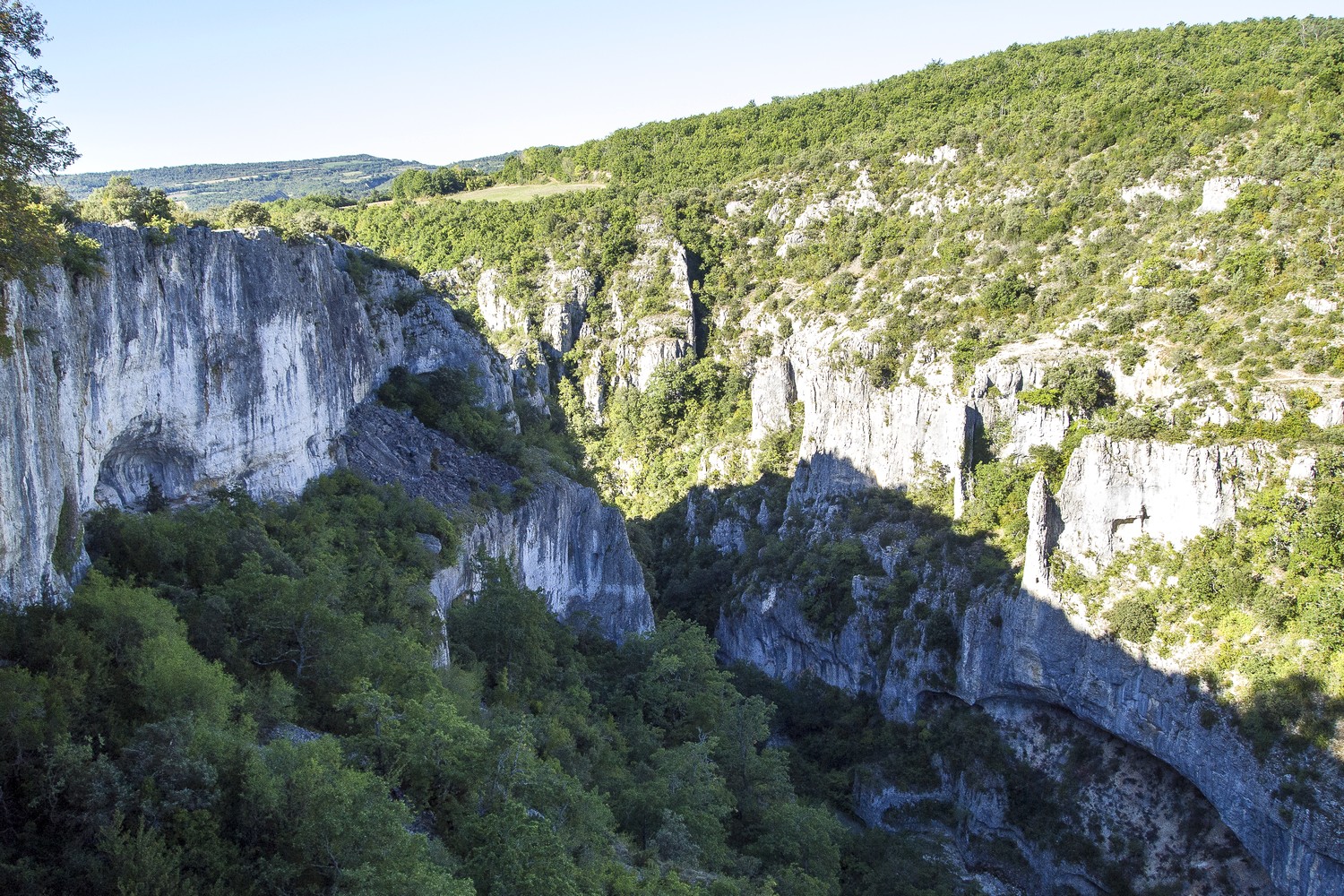
Tour of the Gorges d'Oppedette
23 points of interest
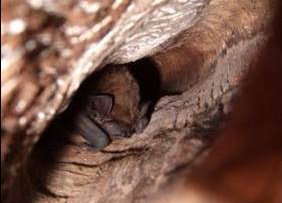
Chauve-souris dans son refuge - ©DR  Fauna
FaunaDo not touch my HLM! (French acronym for housing project)
The configuration of the gorges and the combined presence of the river and cavity trees allow this natural area to ensure a role of ecological corridor for wildlife. The old and big white oaks are home to a significant biodiversity: bats (Barbastelle) and insects (Capricorn, Stag beetle, Osmoderma ...).
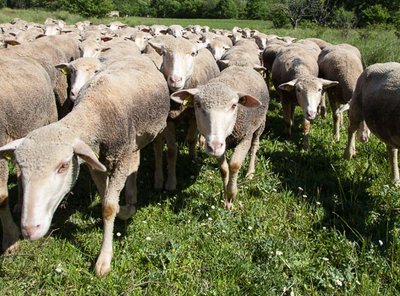
Un troupeau, c'est de l'or ! - ©David Tatin  Elevage et pastoralisme
Elevage et pastoralismeThe Provençal shepherd dedicated to the ground
TheProvençal shepherd is a shepherd who does not own his own land but who concludes a grazing agreement among farmers. After the harvest, the flock benefits of remaining straws on areas too hard to plow The animals feed on straw, but they also eat weeds and sanitize and improve soil fertility. Finally, during the landfilling, the stubble will retain the moisture from the soil. A win-win situation for the farmer and the livestock breeder!
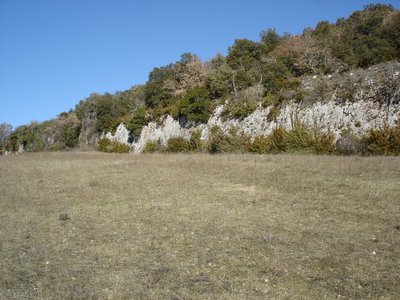
Miroir de faille - ©Stéphane Legal - PNR Luberon  Geology
GeologyA beautifully polished slickenside
The small cliff on the edge of the field is a slickenside. As you approach (while being careful with the crops), you will see on this polished surface, iron deposits and horizontal streaks. All this translates friction and movement of a boulder over the other! The Earth moves. The hard rocks break and boulders move.

Grand-duc d'Europe - ©DR  Fauna
FaunaBubo, the European eagle-owl
The European eagle-owl (Bubo bubo) is the giant of the owl species. As big as an eagle, it is still well represented in the territory of the Luberon Park. Sixty pairs have been identified therein. Its nocturnal habits play a large role. To cope with the disappearance of the rabbit, it has adjusted its eating behavior to feast on rodents, birds, hedgehogs, reptiles, fishes ...
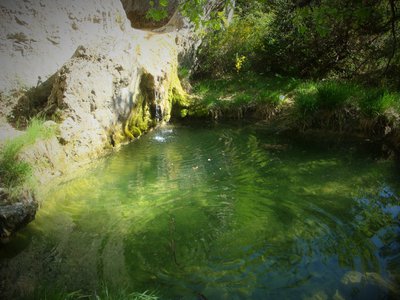
Vasque du Grand Vallat - ©Eric Garnier - PNR Luberon  Water and rivers
Water and riversThe Grand Vallat river, rich and fragile
The Grand Vallat, a wild tributary of the Calavon river is a small canyon amphibians such as the fire salamander (Salamandra salamandra) or the European tree frog with its very powerful croaking take shelter. Be careful, this fragile site is subject to a biotope protection order: canyoneering, aquatic hiking and swimming are strictly forbidden.

Crue du Calavon à Apt en 1994 - ©DR  Water and rivers
Water and riversThe Calavon, a torrential river
When you cross the big bridge of La Blaque, lean towards the Calavon's riverbed, which is most of the time dry or almost dry. But do not be fooled by its quiet appearance. The Calavon is a monster that sleeps! Its large watershed can produce deadly flooding downstream. Notice the early warning system located at the end of the bridge (limnigraph with solar power batteries that can record changes in water level).

La mésange charbonnière - ©DR  Fauna
FaunaThe birds
The cliffs are the territory of the Common Raven recognizable by its resonating croaks. Discreet birds like the Wood Nuthatch (blue and orange) and the Wallcreeper (gray and red) perform stunts on tree trunks. More common species perform their birdsongs (tits, blackbirds and jays).

Dauphinelle fendue - ©DR  Flora
FloraRare and sensitive, I am ...
The Luberon holds nearly a third of the French flora. The gorges of Oppedette in particular have a large vegetable wealth and have several protected species: the Larkspur (Delphinium fissum), the Euphorbias (Euphorbia graminifolia), the Asplenium petrarchae (Asplenium petrarchae) ...
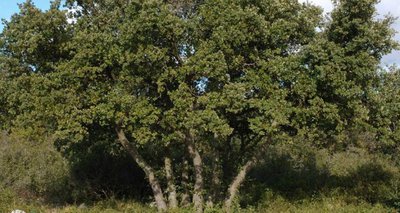
Chêne vert - ©DR  Flora
FloraThe woods
The woods in which you have entered are composed of several species: the Holm oak is the second most present tree behind the predominant Downy oak, and the undergrowth is comprised of shrub species: Butcher's broom, Rowan, Box tree, Field maple ...
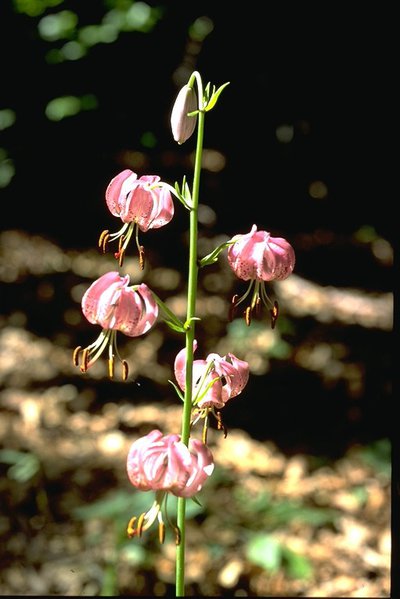
Lis Martagon - ©PNR Luberon  Flora
FloraThe mountain in the ravines
Far from being Mediterranean, the predominant micro-climatic conditions in the gorges resemble more those of mountainous regions; less light, higher moisture, trapped cold air. It is therefore not a coincidence if we can see unusual species here in Provence, such as the European beech (Fagus sylvatica), the Alpine Buckthorn (Rhamnus alpina), the Mountain Currant (Ribes alpinum), or the magnificent Turk's cap lily (Lilium martagon).
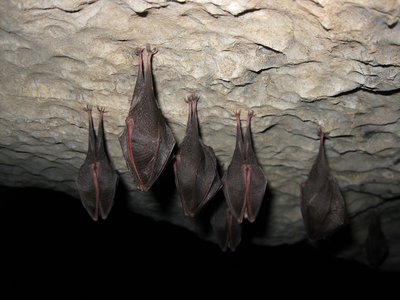
Colonnie de petits rhinolophes - ©DR  Fauna
FaunaSmall but precious flying mammal
Worthy representative of the many bat species, the Lesser Horseshoe Bat (size 4cm, 22cm wingspan, weight 6g) has established on the plateau of Vachères, one of the last bastions of Provence. In winter it occupies favourable underground cavities, such as the sinkhole of the ladder. It starts to hunt between 15 and 30 minutes after sunset. It identifies insects at short distances and captures them most often in flight.
Dauphinelle fendue - ©Laurent Michel - PNR Luberon  Flora
FloraBeauties of the rocks
Viewpoints and ledges attract us for the views they offer... They are also the preferred habitat of a very specific flora which can adjust to extreme drought and lighting conditions. The Larkspur (Delphinium fissum) and lilacs with laciniated leaves (Hesperis laciniata) are two beautiful representative flowers, rare in the local area. The Larkspur is even protected in our region. It is therefore appropriate to keep them out of our quest for view points!
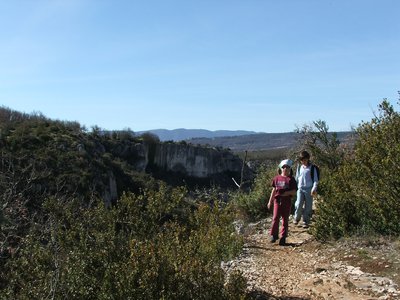
Rive droite des Gorges d'Oppedette - ©Eric Garnier - PNR Luberon  Panorama
PanoramaOn the way, I embrace the Luberon attitude!
The Oppedette site is a remarkably rich and diverse area which, despite the efforts of protection and management, remains very fragile. Let us protect it, together, by following some basic rules of a responsible hiker. The sum of isolated damages is never trivial! On this balcony path, while keeping a grip on the trail, avoid the repeated trampling of plants and insects, such as the formation of gully erosion lanes in the scree.

Polypode vue du dessus - ©DR  Flora
FloraA xxxx of liquorice
At either side of the banks, the bracken fern has spread its roots. It is described and called "réglisse des bois" as some have chewed its roots which gives a taste of liquorice.
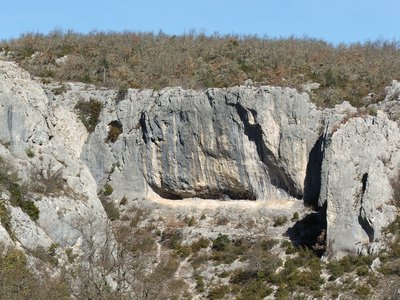
L'unique falaise des gorges ouverte à l'escalade - ©Eric Garnier - PNR Luberon  Panorama
PanoramaThe pleasure of climbing...
If you practice rock climbing, feel free to enjoy a few tracks equipped by the FFME on the cliff overlooking the trail. Because of issues related to the protection of birds, it is the only authorized and equipped area for rock climbing in the gorges of Oppedette. To the right, enjoy the easier lanes and, in the middle, the more difficult ones. After the effort, a splendid view of the entire circus uphill! Please note that free climbing is a sport governed by specific rules of practice; respect them.!

Abeille butinant une fleur de sauge - ©PNR Luberon  Fauna
FaunaA world without bees?
35% of what we eat depends directly on the work of bees. But nowadays, bees are experiencing alarming winter mortality: 20 to 30% of the hives do not survive the winter. Blame the pesticides used in intensive farming that are extremely dangerous to bees. Without bees, it is estimated that 80% of plants would disappear from the lack of pollination.
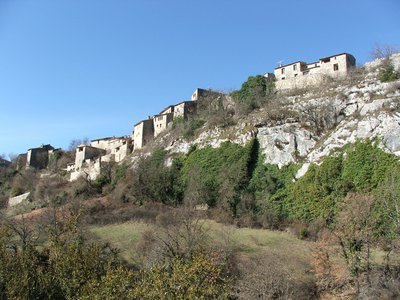
Lierre grimpant sur les falaises du village - ©Eric Garnier - PNR Luberon  Flora
FloraIvy flowers, friend of the bees!
At the edge of the trail, large ivy flowers parade on the cliff. Their flowering lasts from September to October and fruiting occurs in late winter, early spring. The Ivy flower therefore presents a reversed phenological cycle compared to plants. Its flowers are among the last to provide pollen for bees. A bee is directly related to the ivy; Ivy bees (Colletes hederae). You can see it flying until early November if the weather is mild and lenient.

La fontaine du village à plan octogonal - Jérémie Haye - PNR Luberon  Patrimony and history
Patrimony and historyThe wash fountain of the town
Located at the entrance of the village, the building holds a fountain, a wash-house and a drinking trough. Supplied by a spring from the hamlet of Fenouillet, the fountain was built in the mid 19th century. Octagonal in shape, it has a central shaft which is nearly 3.70m high. The wash-house, meanwhile, has two basins: the largest was used for washing; the smallest, near the fountain, used for rinsing.

Oppedette, village perché - ©Eric Garnier - PNR Luberon  Patrimony and history
Patrimony and historyOppedette : Hilltop villages
Overlooking the entrance of the gorges, perched on its rocky spur, the village of Oppedette (whose name comes from the Celtic-Ligurian oppidum on which it was built) was frequented from the Palaeolithic (remains dated of about 40 000 years) . Oppedette is a typical Provencal village with narrow streets and facades where the coating has faded over the time and have exposed the limewashed masonry stones.
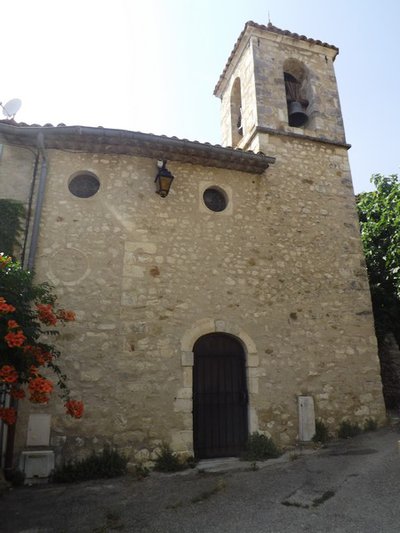
La façade de l'église Saint-Didier - Jérémie Haye - PNR Luberon  Patrimony and history
Patrimony and historyThe church Saint-Didier
The church was built in 1834 on the spot of an ancient chapel as evidenced by the collages and the reuse of masonry on the façade. This later-built building in an already existing structure is why this church is not strictly facing east. In 2000, the town of Oppedette, supported by the technical services of the Park, restored the building to preserve this remarkable element of the rural heritage.
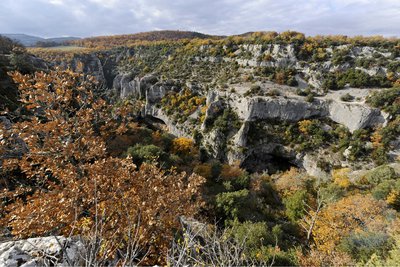
Paysage des gorges en automne - ©Vincent Damorette - Coeurs de nature-Sipa  Panorama
PanoramaA canyon in its wooded setting
Barely visible in the landscape, you will need to go to the site to discover the country of Oppedette, a rugged landscape and covered with woodlands. What reward once on the spot: a "magnificent" landscape reveals the deep gorges forming a canyon that you can embrace or roam. In this wooded setting, viewpoints are occasionally open at the hilltop village of Oppedette and the Lure mountain. These areas seem to have evolved over time without any pressure related to human activity.

Belvédère est d'Oppedette - ©Eric Garnier - PNR Luberon  Panorama
PanoramaTwo prefects, two viewpoints!
"It is here, in the presence of two prefects, that was cut in 1951, the symbolic ribbon of the first gorge trail. Hence the name of ''Belvédère des deux préfets''! From there on, the language uses have simplified the name to ''Belvédère du sous-préfet", then ''Belvédère des gorges''...". Mr. Fayet, a former teacher of Oppedette.
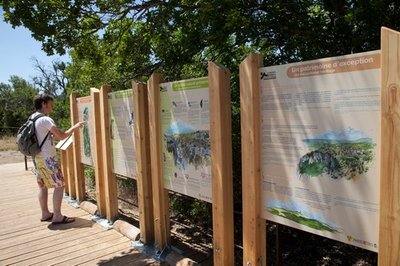
Zone d'accueil de l'ENS - ©Hervé Vincent  Patrimony and history
Patrimony and historyThe ESA (environmentally sensitive area) of the gorges of Oppedette
The department of Alpes de Haute-Provence, with the help of the Region, of the Commune and the Park, got together to accomplish the rational, harmonious and sustainable development of this remarkable but fragile site. The latest landscaping and protection projects were completed in 2009. The entire project of the sensitive natural areas or ESA (study, acquisitions, works) cost €287 641. ! It is now up to all the visitors to contribute to its preservation, adopting a responsible behaviour.
Description
From the car park and the two belvederes which face each other (accessible to disabled people), go south on the truffled path of lapiaz, which runsmore or less far from the edge of the cliff (vigilance!).
1 - Cross the D201 to continue in front a path that runs alongside a lavender field. Leave the road slightly left, then take the road a little further down. Go down the road for about 30m.
2 - Take the path to the right and join the rock ledge. Farther, the slanting path to the left bypassed the valley of the Grand Vallat. Take the D201, turn right, past the parking lot and cross the large bridge of La Blaque that spans the Calavon.
3 - Right after, take the path on the right to go up the right bank of the gorge. Climb gradually, cross a valley, and emerge on an old collier. After a rocky section (lapiaz), cross two other valleys. Then, go down on the ledge towards the cliff edge (caution!). Reach the end of the ladder, hidden at the edge of the trail.
4 - Continue the path on the ledge, climb up a shortmoment, then cross a rocky pass. Then go down between the cliff edge and a rock slide, to reach the upstream circus of the gorges. At the end of the beautiful cliff, hurtle down the switchbacks up to the river.
5 - Cross the Calavon (caution in the event of a flood!), go in front and then, through a stony path, join the village at the top of the rocky spur. In front of the town hall, turn right, enter the heart of the village and go up to the left an alley to end up on the plateau. Leave the obvious wide path, take a right at the cemetery and follow the trail through the grass to emerge again at the base of the gorges. Turn left and go to the starting car park.
- Departure : Parking area of the Belvédères, in Oppedette
- Arrival : Parking area of the Belvédères, in Oppedette
- Towns crossed : Oppedette
Forecast
Altimetric profile
Recommandations
Specific difficulties: some delicate passages at the top of the cliffs and inconvenient rocky sections (lapiaz). Avoid in rain or fog. Remember to take enough water, especially when the sun is strong!
Information desks
House of the Luberon Regional Nature Park
60, place Jean Jaurès, 84400 Apt
In the heart the old town centre of Apt, the House of the Luberon Regional Nature Park welcomes you in a town house of the 18th century. The permanent exhibition of the geology museum has a rich collection of fossils evidencing the geological history of the Luberon.
On sale at the shop: books, maps, guidebooks, games, posters...
Open Monday to Friday from 8:30 am to 12:00 pm and from 1:30 pm to 6 pm (and on Saturday, depending on the program). Free admission.
OTI Pays d’Apt Luberon
788 avenue Victor Hugo, 84400 Apt
Du 1er avril au 30 septembre
Ouvert du lundi au samedi de 9h30 à 12h30 et de 14h à 18h.
Juillet et août : Ouvert dimanche et jours fériés de 9h30 à 12h30
Du 1er octobre au 31 mars
Ouvert du lundi au mardi et du jeudi au samedi de 9h30 à 12h30 et de 14h à 18h.
Fermé le mercredi, dimanche et jours fériés.
Transport
Access and parking
From Apt, take the D900 for 15 km then take the D33 and D155 towards Oppedette. From Forcalquier, take the D4100 for 25 km then 3 km after Céreste, take the D33 and D155 towards Oppedette.
Parking :
Access
A parking area, a viewpoint and information panels are available to persons with disabilities in the parking area of the viewpoints located at the southern entrance of the village.
- Emergency number :
- 114
Report a problem or an error
If you have found an error on this page or if you have noticed any problems during your hike, please report them to us here:


